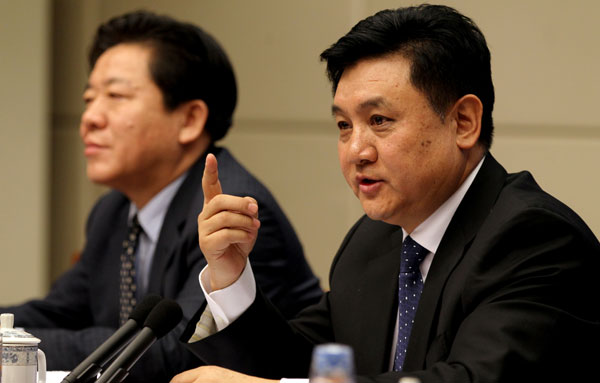Air quality efforts lauded
Updated: 2012-03-03 07:53
By Zheng Xin (China Daily)
|
|||||||||||
BEIJING - The government appreciates the environmental protection work done by NGOs and looks forward to further mutual communication and understanding, the Ministry of Environmental Protection said on Friday.
"The active participation and involvement in monitoring of particulate matter pollutants illustrates that the public has increased its awareness of environmental protection," Wu Xiaoqing, deputy environmental protection minister, said at a State Council Information Office news conference.
|
 |
|
Wu Xiaoqing, deputy minister of environmental protection, talks to reporters at a news conference in Beijing on Friday. Wu said revised air quality standards, including an index for particulate matter less than 2.5 micrometers in diameter, will be adopted throughout the country by Jan 1, 2016. Feng Yongbin / China Daily |
"The support and understanding of the public is very much appreciated," he said.
Some volunteer monitoring of pollutants suggests that the current monitoring data do not meet the public demand and there is room for improvement, Wu said.
The Ministry of Environmental Protection has in the past invited members of the public to the monitoring laboratory to show how the work is conducted by the government. Environmental testing personnel have demonstrated the air quality monitoring technologies to residents and environmental protection volunteers to help them understand the processes.
However, no matter what methods are applied to evaluate air quality, the top priority lies in reducing the concentration of PM2.5 (particulate matter of 2.5 micrometers or smaller).
Wu said that new air quality standards and evaluation specifications comply with international practices and the air quality data collected by the embassies in China cannot truly reflect the quality of air in the city.
"Accurately monitoring a city's air quality relies on technological standards in the qualifications of the monitoring personnel, the location of the monitoring station and the analytical approach as well as the selection of the monitoring equipment," said Wu.
The revised air quality standards will take account of six pollutants - sulfur dioxide, nitrogen dioxide, carbon monoxide, ozone, PM10 and PM2.5 - and representatively cover an area with an accurate monitoring data.
Two-thirds of the cities in China will be substandard under the revised guidelines, according to the ministry.
"That doesn't mean the air quality in those cities is worsening," said Wu. "It's just that more stringent criteria have been adopted to fundamentally improve the air."
To that end, the government is speeding up coordinated pollution control between neighboring cities and focusing on reducing the intensity of prominent problems
Wu said some cities have more experience in pollution control. The capital for example is employing measures now and had during the 2008 Olympics. Such experience is worth spreading nationwide, he said.
Fifty cities in China are well prepared to start monitoring the concentration of PM2.5 as well as ozone so far, and six others can monitor one or the other, according to the ministry.
By the end of 2015, more than 1,500 monitoring stations will be set up nationwide with an investment exceeding two billion yuan ($320 million), according to Wu.
Li Jing contributed to this story.
Related Stories
PM 2.5 to be monitored nationwide 2012-02-21 16:51
Beijing vows to slash PM2.5 pollution 2012-02-09 07:01
Beijing to set up PM2.5 monitoring stations 2012-02-01 16:58
PM 2.5 top of capital's agenda 2012-02-07 17:05
Today's Top News
President Xi confident in recovery from quake
H7N9 update: 104 cases, 21 deaths
Telecom workers restore links
Coal mine blast kills 18 in Jilin
Intl scholarship puts China on the map
More bird flu patients discharged
Gold loses sheen, but still a safe bet
US 'turns blind eye to human rights'
Hot Topics
Lunar probe , China growth forecasts, Emission rules get tougher, China seen through 'colored lens', International board,
Editor's Picks

|

|

|

|

|

|





